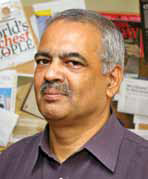Sun Pharma rises from the ashes of Ranbaxy as global generics powerhouse
May 05, 2014 | Monday | Views | By BioSpectrum Bureau
Mr Narayanan Suresh is the Chief Editor of BioSpectrum
For more than four decades the Ranbaxy star shined brightly over India's pharma landscape and also in the global generics markets thanks to the immense help provided to it by the company's Japanese collaborator, Shionogo & Company, the developer of cholesterol-lowering drug, Crestor. But it was left to another Japanese company, Daiichi Sankyo, to bring the controversial chapter of Ranbaxy to an end in April 2013.
Yes. That is the clear message from the $4 billion sale of Ranbaxy by Daiichi Sankyo to a new suitor, Sun Pharamceuticals in early April 2013. Daiichi which bought majority stake in Ranbaxy for nearly $7 billion in 2008 has cut its losses by exiting at half the purchase price. Ranbaxy has been in the news for all the wrong reasons in the past few years, such as falsifying clinical trial data to get drug approvals in the US and for poor quality of some of its products. In fact, Ranbaxy had to pay a hefty fine of more than $500 million to settle some of these claims in recent years.
What is clear is that Sun Pharma has picked up Ranbaxy for its manufacturing facilities across the globe and access to markets in African and Latin American countries. Sun Pharma, the Indian generics major, will now move to the 5th position globally in terms of generics market size. However, it will have no use for Ranbaxy name after some time and so the brand which of late is synonymous with everything that is wrong with a business model that exploits regulatory loopholes will die a natural death.
It did not start this way. Two Sikh brothers formed this company in undivided India in 1937 to distribute medicines from Shionogo. The company was bought over in 1957 by their cousin Bhai Mohan Singh. And the Japanese company helped Ranbaxy set up manufacturing facilities in the 1950s and 1960s and soon Ranbaxy became a stellar example of an Indian enterprise. This is what prompted Daiichi Sankyo to buy into Ranbaxy in 2008 and ride on its global reach. But what it overlooked was apparently the rotten core inside the heart of Ranbaxy's operations. All the good will seems to have been blown under the leadership of the third generation family members who shut their eyes on questionable manufacturing and business practices, leading to the eventual fall from glory for a brand name that was once synonymous with quality medicines.
Ranbaxy-Sun Pharma is not the only deal which made waves in April. A $20-billion 3-way swap of oncology, vaccine and animal product brands between GSK, Novartis and Eli Lilly, has also made waves around the world. With these deals, GSK consolidates its position as a global vaccine leader, Novartis enhances its already formidable presence in cancer treatment products and Eli Lilly, surprisingly emerges as the world No 2 in animal health products. Some more rounds of deal makings are expected as Novartis while shedding its vaccine portfolio has retained influenza vaccine products. Expect it to unload it soon at a hefty premium.
To top it, the rumor of a $100 billion offer to Pfizer to buy out AstraZeneca is also swirling around. If that happens in the near future, there will one less Big Pharma company










